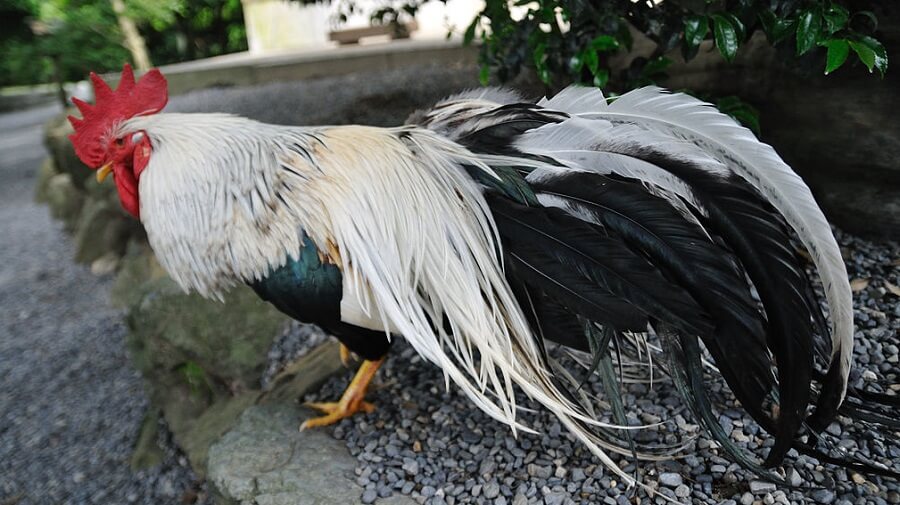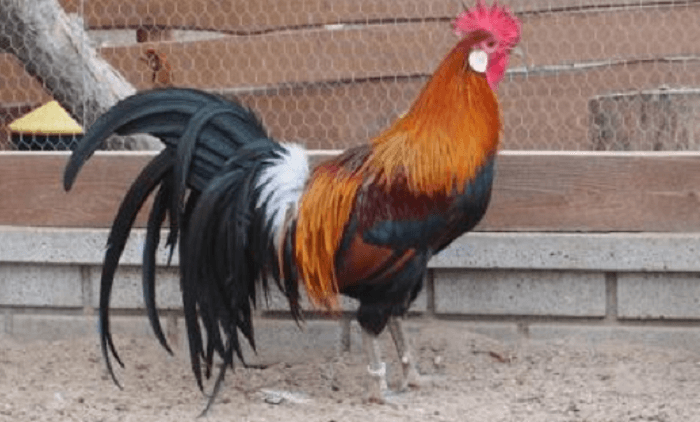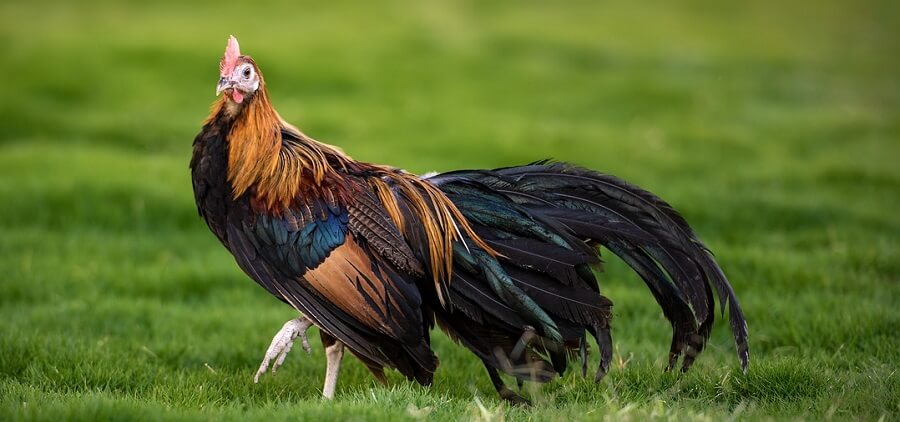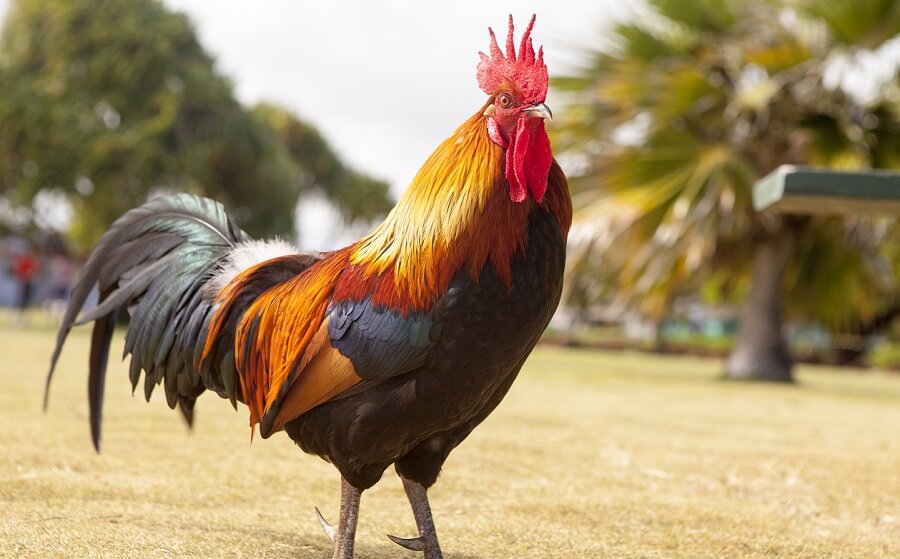Raising chickens isn’t just about the highest egg production or the fastest-growing meat. It’s also about having fun and enjoying your chickens. Some chicken breeds are fun, gorgeous, and unique. These Japanese chickens will turn your neighbors heads and be the talk of the town.
What Are The Prettiest Chickens? Although the term “prettiest” is subjective, generally the four chicken breeds that are thought to be the prettiest chickens in the world come from Japan. They the Onagadori, Phoenix, Shoukoku, and Totenko chicken breeds. Additionally, the Silkie, Polish, and Sultan chicken breeds are considered to be some of the loveliest and most unique chickens in the world.
Of these prettiest chicken breeds, four of them originate from Japenese Chicken breeds. Those breeds are:
In addition to being rare and exotic, these breeds have also helped to start several modern breeds. Sadly, the original breeds are very rare. Raising chickens in any of these breeds will help to conserve the breed.
Onagadori Chicken: Rare Japanese Long-Tailed Chicken

Onagadori chickens are very rare, even in Japan where they have been cultivated for hundreds of years. Onagadori are very long-tailed chickens.
Onagadori chickens were designated a Japanese National Treasure in 1952. It comes from the Shikoku island in South Japan.
Onagadori means either “honorable fowl” or “long-tailed chicken,” depending on the translation.
They have been bred with a rare gene that doesn’t molt the tail feathers. As a result, the tails can get exceptionally long, as long as 30 feet.
Emperors bred this trait and used the Onagadori as ornamental birds in royal gardens. The bird traces it’s breed back to the 1600s.
In order for Onagadori chickens to get such long tail feathers, special care must be taken to protect the roosters from weather, mud, dirt and wear.
Roosters are generally 4 lbs and hens grow to 3 lbs.
Purebred Onagadori are very rare. It is thought that there are no purebred in the United States and less than 1,000 purebreds in Japan.
Phoenix Chicken: Gorgeous Japanese Descendants
In Germany, the Phoenix was bred from the Onagadori Chicken, an ancient Japanese chicken breed. Onagadori Chickens have a rare gene that stops molting so tail feathers grow to be as much as 22 feet long.
But, they take specialized care and grooming. Onagadori chickens are also very delicate in their health. In Germany, Mr. Hugo du Roi wanted to create a healthier, hardier chicken from the Onagadori.
He bred a small number of imported Onagadori with other local chickens including the Malay, Leghorn, Modern Game and others, to make a heartier chicken.
As a result, Phoenix Chicken molt every year or two, but are still able to grow long beautiful feathers. Their sickle feathers can get between 2-5 feet long, depending on the specific heritage of the chicken. The saddle feathers can grow to 12-18 inches.
He named them Phoenix because the chicks seemed to “rise from the ashes” of their soon dead parents. They were imported to the USA before 1924. (The feature chicken is also a Phoenix chicken)
Reasons To Own A Phoenix Chicken
The Phoenix chicken is a beautiful ornamental chicken. It is often raised for shows or to add beauty and grace to an existing flock. When a Phoenix is around, there is always a conversation starter.
Many people have never seen such beautiful, colorful chickens and are fascinated by them. Phoenix chickens are also lovely in shows.
Phoenix are ok layers. They lay about 1 small-medium sized egg a week. The egg will be cream-colored or slightly tinted. They can lay as many as 70 eggs a year.
The hens go broody fairly often and make pretty good mothers. Roosters grow to 5.5 lbs (2.26 kgs) and hens grow to 4 lbs (1.81 kgs).
Physical Traits Of Phoenix Chickens
A Phoenix chicken has beautiful, long tails. Although they aren’t as long as Onagadori chicken tails, they are lovely and make a beautiful addition to any backyard or farm.
They have three recognized colors, Silver, Golden, and Black-breasted. They have white earlobes and red wattles and combs. Their comb is a single comb with 5 points.
The silver Phoenix chickens were accepted into the American Poultry Association in 1965. Gold was accepted in 1983 and black-breasted in 2018. Phoenix was accepted into the Australian Poultry Standard in 2012.
Phoenix chicken breeds are considered by many to be a heritage breed chicken. They are hardier than their ancestors and should live for 5-7 years. They may live longer, but there are not enough purebred Phoenix chickens to get an accurate average age. Most are killed by predators or die other premature deaths.
Caring For Your Phoenix Chicken
Phoenix chickens have pheasant-like characteristics that come from their more wild parents. They like to perch in high places and trees. They can fly and need a lot of room. If they are cooped, they need a large coop. Otherwise, the other chickens step on their tail feathers.
Your Phoenix chickens will also need extra protein while their tails are growing. This will help to keep them healthy.
They will also need their coop cleaned frequently to keep their tail feathers from picking up the muck from the coop.
They do very well in a free-range environment because they are very alert and active. Phoenix chickens are good at roaming and they like freedom.
They are not cold hardy but do pretty good in the heat. Phoenix chickens are shy chickens and not usually friendly to people. They can be tamed if they are handled often from a very young chick.
They are listed in a watch status by the American Livestock Conservancy.
| Climate | Personality | Use | Size | Eggs/ Yr | Brooder | Forages |
| Hot | Shy | Ornamental | M: 5.5 lbs
F: 4 lbs |
50 | Yes | Yes |
- Long-tailed ornamental chickens
- Heat hardy
- Colorful & beautiful
Shoukoku Chickens: The Original Long-Tailed Chicken
The Shoukoku, also spelled Shokoku, is believed to have been the ancestor to all the other long-tailed chickens including the Phoenix and the Onagadori chickens. However, recent DNA tests indicate that it isn’t the case unless the Shoukoku are very ancient ancestors.
It was originally imported to Japan from China 2,000 years ago.
It is a very popular bird in Japan but is very hard to find in the US. Many heritage Shoukoku can be found in Germany.

Photo Credit: Wikimedia
Shoukoku Chicken Traits
Shoukoku is a smaller bird. Roosters grow to 4.4 lbs (2 kgs) and hens to 3.5 lbs (1.6 kgs). Shoukoku have red comb, wattles, and earlobes. They have yellow legs.
There are many colors including black-breasted, silver and white. They are mostly used as ornamental chickens but are sometimes used for meat.
M 4.4. Lbs F 3.5 lbs red comb, wattles, earlobes,
Eggs are tinted. I couldn’t find any information on how many eggs Shoukoku hens lay a year.
Until the 1860s most chickens in Japan were raised as ornamental chickens and weren’t eaten.
There are other Japanese breeds of chicken including the Gashiwa, Koeyoshi, Tomaru, and Totenko.
- Extremely rare in the United States
- Original Long Tailed Chicken
- Used as ornamental chickens
Totenko Chickens: A Japanese Rarity
Totenko Chickens are a very rare Japanese breed of chickens. They are exceedingly rare.
Totenkos are a Japanese national monument chickens. It is a long crowning and long-tailed chicken. It looks a lot like a Phoenix.
Phoenix chickens have slate colored legs and Totekno chickens have olive green legs. They also have a bigger fanned tail than Phoenix.
They have white earlobes and red wattles. Their coloring is red hackled.
Roosters grow to 5 lbs (2.2 kgs.) Hens grow to 4 lbs (1.8 kgs.)
They are not very hardy outside of Japan. This is especially true if they are caged.
Totenkos have done better outside of Japan when they have been free-ranged.
They are prolific layers and lay about 120 eggs a year, another difference from the Phoenix.

| Climate | Personality | Use | Size | Eggs/ Yr | Brooder | Forages |
| Not hardy | Shy | Ornamental | M: 5 lbs
F: 4 lbs |
120 | Yes | Yes |
- Must free-range
- Lovely long tail
- 120 eggs a year
Other Gorgeous Japenese Chicken Breeds
There are so many exotic Asian chicken breeds, but several from Japan are simply amazing.
The Shamo Chickens are brightly colored, upright chickens that will make your visitors double take when they see your flock.
Conclusion
While these beautiful chickens are rare, the Phoenix and Shoukoku chickens can be found and purchased in Europe, Australia, and North America. They are beautiful show birds with rare plumage.
These four chicken breeds will definitely make your neighbors turn green with jealousy. They will provide beautiful eye candy and be entertaining to watch.
But, if you want a little less-rare chicken that is still beautiful and unique, then check out these beautiful chickens that add variety to your flock.
My Favorite Chicken and Duck Supplies
This list contains affiliate products. Affiliate products do not cost more but helps to support BestFarmAnimals and our goal to provide farm animal owners with accurate and helpful information.
Manna Pro Oyster Shell keeps eggs strong. Before I gave my chickens oyster shell, I had the oddest eggs, many with weak and irregular shells. Now, I don’t have an issue.
Layer Feed by Manna Pro. I like pellets rather than crumbles as my chickens eat them better and less gets wasted or scavenged by rodents. A good layer feed makes the difference in hens laying many more eggs.
My chickens love this mealworm treat, which gives added protein, something that’s great during molting and winter months.
There are many ways to feed and water your chickens. I like this food and water setup the best because it reduces waste, saves me time feeding and watering, and keeps the food fresh longer. Except, in the winter, I use a heated waterer. The only problem is the heated waterers need to be replaced every few years.
I love this chicken veggie hanger. It makes it easy to give your chickens produce from the garden and keep them occupied in the winter with a fresh head of lettuce.
These chicken toys are a hoot! They will help curb bullying and keep your chickens active, especially in the winter when hens tend to get more lethargic.


